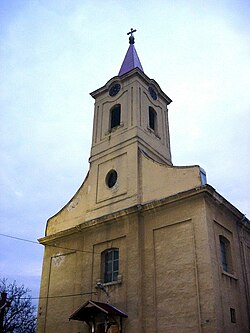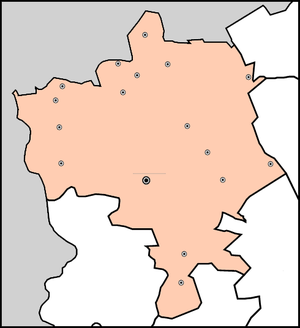Bački Breg (Serbian Cyrillic: Бачки Брег, Hungarian: Béreg) is a village located in the Sombor municipality, in the West Bačka District of Serbia. It is situated in the autonomous province of Vojvodina. As of 2022, it has a population of 769 inhabitants. The village has a Croat (Šokac) ethnic majority.
Bački Breg | |
|---|---|
 Saint Michael the Archangel Catholic Church. | |
| Coordinates: 45°55′N 18°56′E / 45.917°N 18.933°E | |
| Country | |
| Province | |
| Region | Bačka (Podunavlje) |
| District | West Bačka |
| Municipality | Sombor |
| Area | |
| • Total | 52.55 km2 (20.29 sq mi) |
| Elevation | 92 m (302 ft) |
| Population (2022) | |
| • Total | 769 |
| • Density | 15/km2 (38/sq mi) |
| Time zone | UTC+1 (CET) |
| • Summer (DST) | UTC+2 (CEST) |
Bački Breg is in the very northwest of Serbia, on an important highway linking Serbia and Hungary together. The Hungarian town across the border is Hercegszántó.
Name
editIn Serbian the village is known as Bački Breg or Бачки Брег, in Croatian as Bereg (since 2009)[2] or Bački Breg (before 2009), in Hungarian as Béreg, and in German as Bereg.
History
editIt was first mentioned in 1319. In 1620, the village was settled by Šokci who originating from Klis near Split. The first church in the village was founded in 1740. In the 18th century, Germans and Hungarians settled here as well.
Demographics
editAs of 2022 census results, the village has 769 inhabitants.
Historical population
edit- 1961: 2,045
- 1971: 2,006
- 1981: 1,770
- 1991: 1,585
- 2002: 1,388
- 2011: 1,140
- 2022: 769
Ethnic groups
editThe ethnic composition of the village (2002 census):
| Ethnic group | Population | % |
|---|---|---|
| Croats | 738 | 53.17% |
| Serbs | 344 | 24.78% |
| Yugoslavs | 67 | 4.83% |
| Hungarians | 34 | 2.45% |
| Others | 76 | 5.48% |
| Undeclared/Unknown | 129 | 9.29% |
| Total | 1,388 |
See also
editReferences
edit- Slobodan Ćurčić, Broj stanovnika Vojvodine, Novi Sad, 1996.
- ^ "Насеља општине Сомбор" (PDF). stat.gov.rs (in Serbian). Statistical Office of Serbia. Archived from the original (pdf) on 14 November 2015. Retrieved 24 October 2019.
- ^ (in Croatian) Radio Subotica Archived 2011-07-26 at the Wayback Machine Tradicijski nazivi naselja vraćaju mještanima osjećaj sigurnosti, Nov 20, 2009, accessed Nov 23, 2009
External links
edit




